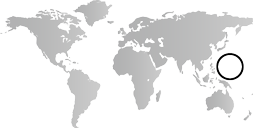Although the Spanish colonize Guam and the other Mariana Islands in the 1500s and briefly visit other Micronesian islands, it is not until the nineteenth century that the more remote archipelagos of Micronesia are completely explored. As is the case in Polynesia, the islands of Micronesia are eventually charted through the combined efforts of official exploring expeditions and the chance discoveries of whalers and other commercial vessels. Along with steel tools and other aspects of Western technology, European and American sailors introduce diseases such as smallpox, which decimate the populations of many Micronesian islands. During the 1850s and 1860s, European traders establish outposts on a number of Micronesian islands, including Yap, Kiribati, and the Marshall Islands, and the first Christian missionaries begin to arrive. In one case, an American sailor, David O’Keefe, who is shipwrecked on Yap in the Caroline Islands in 1871, plays a significant role in perpetuating one Micronesian artistic tradition. Over the next thirty years, in exchange for copra (dried coconut meat), a valuable trade commodity, O’Keefe uses a Chinese junk to assist the Yapese in transporting their enormous stone money disks, which they quarry in the neighboring archipelago of Belau. The largest examples of Yapese stone money, some up to four meters across, are brought to the island during the “O’Keefe” period.
After more than a century of increasing Western contact, in the last two decades of the 1800s all the islands of Micronesia are brought under European colonial control. In the 1880s, Germany claims the Marshall Islands and Nauru. The Germans also claim the Caroline Islands, including Belau, although their claims are disputed by Spain. In the 1890s, Germany formally purchases the Caroline Islands, Belau, and the Northern Mariana Islands from Spain, Britain establishes a protectorate over Kiribati, and the United States assumes authority over Guam following the Spanish-American War. After more than three centuries as the sole colonial power in the region, by 1900 Spain no longer controls any portion of Micronesia.
Despite the growing impact of Western culture, Micronesia’s traditional art forms continue to flourish and develop throughout the 1800s. The gradual decline of the Saudeleur dynasty on Pohnpei in the Caroline Islands leads to the abandonment of the megalithic city of Nan Madol in the 1820s, bringing to a close some six centuries of continuous habitation. However, Micronesia’s other architectural traditions, such as the erection of richly carved and painted ceremonial houses in Belau, thrive. Throughout the region, men retain their traditional role as carvers, creating elegantly stylized bowls, canoe ornaments and equipment, and ceremonial vessels as well as rarer examples of figural sculpture. Women create intricate and colorful loom-woven textiles as well as an enormous variety of works in plaited fiber, including fans, mats, and bodily ornaments such as bracelets and headbands.


